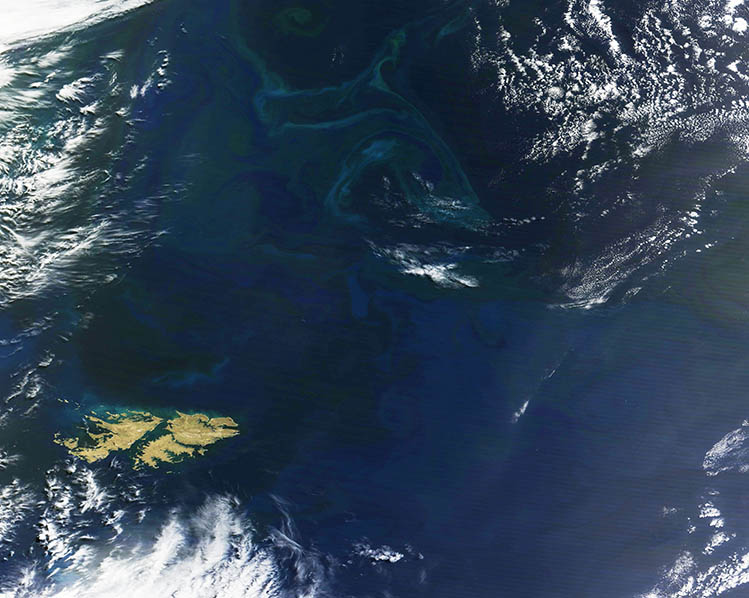Images
November 5, 2024 - Bloom in the South Atlantic Ocean
Tweet
Swirls of green and turquoise filled the South Atlantic Ocean near the Falkland Islands in early November 2024. The Moderate Resolution Imaging Spectroradiometer (MODIS) on NASA’s Terra satellite acquired this true-color image of the colorful scene on November 3.
The bright colors are caused by massive blooms of microscopic plant-like organisms called phytoplankton. These tiny organisms contain chlorophyll and other pigments and thrive in nutrient-rich waters, such as can be found in the Malvinas (Falkland) Current which sweeps cold water from near the Antarctic northward and around the Falkland Islands. When conditions are favorable (adequate sunlight, correct temperatures, and enough nutrients), phytoplankton begin to reproduce explosively, forming floating colonies known as blooms. Blooms are common in this region of the South Atlantic.
The Falkland Islands, also known as Islas Malvinas, are a group of more than 700 islands situated in the South Atlantic Ocean, about 500 km (310 miles) east of southern Argentina. Just two of the islands—East Falkland and West Falkland—comprise the bulk of the Connecticut-sized landmass.
Image Facts
Satellite:
Terra
Date Acquired: 11/3/2024
Resolutions:
1km (316.8 KB), 500m (903.7 KB), 250m (2.4 MB)
Bands Used: 1,4,3
Image Credit:
MODIS Land Rapid Response Team, NASA GSFC
Tweet
Swirls of green and turquoise filled the South Atlantic Ocean near the Falkland Islands in early November 2024. The Moderate Resolution Imaging Spectroradiometer (MODIS) on NASA’s Terra satellite acquired this true-color image of the colorful scene on November 3.
The bright colors are caused by massive blooms of microscopic plant-like organisms called phytoplankton. These tiny organisms contain chlorophyll and other pigments and thrive in nutrient-rich waters, such as can be found in the Malvinas (Falkland) Current which sweeps cold water from near the Antarctic northward and around the Falkland Islands. When conditions are favorable (adequate sunlight, correct temperatures, and enough nutrients), phytoplankton begin to reproduce explosively, forming floating colonies known as blooms. Blooms are common in this region of the South Atlantic.
The Falkland Islands, also known as Islas Malvinas, are a group of more than 700 islands situated in the South Atlantic Ocean, about 500 km (310 miles) east of southern Argentina. Just two of the islands—East Falkland and West Falkland—comprise the bulk of the Connecticut-sized landmass.
Image Facts
Satellite:
Terra
Date Acquired: 11/3/2024
Resolutions:
1km (316.8 KB), 500m (903.7 KB), 250m (2.4 MB)
Bands Used: 1,4,3
Image Credit:
MODIS Land Rapid Response Team, NASA GSFC




